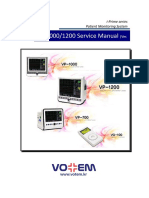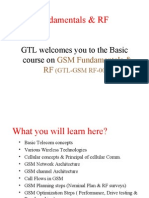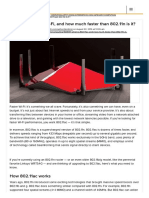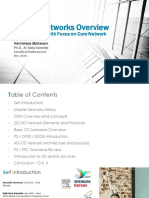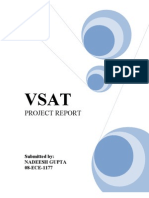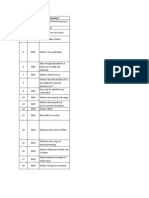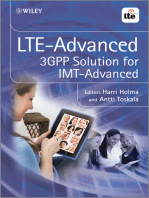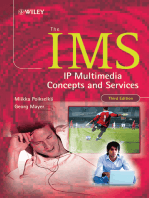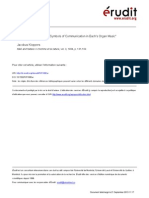0 ratings0% found this document useful (0 votes)
305 viewsBasic Telecom Concepts
Basic Telecom concepts
Various Wireless Technologies
Cellular concepts & Principal of cellular Comm.
GSM Network Architecture
GSM channel Architecture
Call Flows in GSM
GSM Planning steps (Nominal Plan & RF surveys)
GSM Optimization Steps ( Performance, Drive testing & Benchmarking)
Uploaded by
Malik MazharCopyright
© © All Rights Reserved
Available Formats
Download as PPT, PDF, TXT or read online on Scribd
0 ratings0% found this document useful (0 votes)
305 viewsBasic Telecom Concepts
Basic Telecom concepts
Various Wireless Technologies
Cellular concepts & Principal of cellular Comm.
GSM Network Architecture
GSM channel Architecture
Call Flows in GSM
GSM Planning steps (Nominal Plan & RF surveys)
GSM Optimization Steps ( Performance, Drive testing & Benchmarking)
Uploaded by
Malik MazharCopyright
© © All Rights Reserved
Available Formats
Download as PPT, PDF, TXT or read online on Scribd
You are on page 1/ 111
GSM Fundamentals & RF
GTL welcomes you to the Basic
course on GSM Fundamentals &
RF (GTL-GSM RF-001)
What you will learn here?
Basic Telecom concepts
Various Wireless Technologies
Cellular concepts & Principal of cellular Comm.
GSM Network Architecture
GSM channel Architecture
Call Flows in GSM
GSM Planning steps (Nominal Plan & RF surveys)
GSM Optimization Steps ( Performance, Drive testing &
Benchmarking)
BASIC Telephony
Off Hook
Dial Tone
Dialing Digits
RBT
Conversation
Ring
Off Hook &
Conversation
Signaling
Traffic
SWITCH / EXCHANGE
Wireless Communication
Alternative means of wireless communication
Walkie - Talkie
Pagers
Trunked private radios
Mobile Phone - the magic technology that enables
everyone to communicate anywhere with anybody.
Wireless Telephony
BSC
BTS
BTS
Mobile Subscriber...
MSC
Different Standards Worldwide
Till 1982 Cellular Systems were exclusively Analog Radio
Technology.
Advanced Mobile Phone Service (AMPS)
U.S. standard on the 800 MHz Band
Total Access Communication System (TACS)
U.K. standard on 900 MHz band
Nordic Mobile Telephone System (NMT)
Scandinavian standard on the 450 & 900 MHz band
Different Standards Worldwide
GSM - 900
The term GSM-900 is used for any GSM system which operates in any 900 MHz band.
P-GSM - 900
P-GSM-900 band is the primary band for GSM-900 Frequency band for primary GSM-900 (P-GSM-900) : 2 x
25 MHz
890 915 MHz for MS to BTS (uplink)
935 960 MHz for BTS to MS (downlink)
E-GSM - 900
In some countries, GSM-900 is allowed to operate in part or in all of the following extension band. E-GSM-
900 (Extended GSM-900) band includes the primary band (P-GSM-900) and the extension band :
880 890 MHz for MS to BTS (uplink)
925 935 MHz for BTS to MS (downlink)
R-GSM-900
R-GSM-900 (Railway GSM-900) band includes the primary band (P-GSM-900) and the following extension
band:
876 890 MHz for MS to BTS (uplink)
921 935 MHz for BTS to MS (downlink)
GSM-1800
Frequency band: 2 x 75 MHz
1710 1785 MHz for MS to BTs (uplink)
1805 1880 MHz for BTS to MS (downlink)
Different Standards Worldwide
Industry Vs Technology Spread
Telecom Service Providers/Operators
GSM
CDMA
Basic-WLL
Internet Services
Long Distance
Vendor
Telecom Consultancy
Analog Mobile Telephony
End of 1980s Analog Systems unable to meet continuing
demands
Severely confined spectrum allocations
Interference in multipath fading environment
Incompatibility among various analog systems
Inability to substantially reduce the cost of mobile
terminals and infrastructure required
Digital Mobile Telephony
Spectrum space - most limited and precious resource
Solution - further multiplex traffic (time domain)
Can be realized with Digital Techniques only
GSM History and Organization
1979 Europe wide frequency band reserved for
Cellular
1982 Groupe Speciale Mobile created within
CEPT
1986 GSM had full time in Paris
1988 ETSI takes over GSM Committee
1990 The phase 1 GSM Recommendations
frozen
1991 GSM Committee renamed Special Mobile
Group and GSM renamed as Global
System for Mobile Communication
1992 GSM launched for commercial
operations
Service Industry
Service Provider is not a Equipment Manufacturer.
The Service Provider has a license to operate in a
geographical boundary (state/circle/ country).
It buys equipment from OEM Suppliers (Vendors).
Installs & commissions the equipment thus making its
own Network.
Provides the desired service to its subscribers.
Vendor
Vendor is a Equipment Manufacturer.
It supplies Product, Consultancy and Trainings
Service provider has the option of taking the Consultancy
and Training
Cellular Communication
A cellular system links Mobile subscribers to Public
Telephone System or to another Mobile subscribers.
It removes the fixed wiring used in a traditional telephone
installation.
Mobile subscriber is able to move around, perhaps can travel
in a vehicle or on foot & still make & receive call.
Advantage of Cellular
Communication
Mobility
Flexibility
Convergence
Greater QOS
Network Expansion
Revenue/Profit
WHAT IS CELLULAR TELEPHONY ?
CONSIDERATIONS -
FREQUENCY
SUBSCRIBER
DENSITY
COVERAGE
Base Station
Base Station
Base Station
Base Station
Base Station
Base Station
The Cell
Cellular Radio involves dividing a large service area into
regions called cells.
Each cell has the equipment to switch, transmit and receive
calls.
Cells - Reduce the need of High powered transmission
Cells - Conventionally regarded as being hexagonal, but in
reality they are irregularly shaped.
Cell shape is determined by the nature of the surrounding
area e.g. Hills , tall building etc.
Cell Size
Large Cells
35 Km
Remote Areas
High Transmission
Power
Few subscribers
Small Cells
Near about 1 KM
Urban Areas
Low Transmission
Power
Many Subscribers
Coverage & Capacity
Coverage
Percentage of the geographical area covered by cellular
service where mobile telephony is available
Capacity -
Number of calls that can be handled in a certain area
within a certain period of time.
Capacity can also refer to the probability that users will
be denied access to a system due to the simple
unavailability of radio channels.
Frequency Spectrum
Designation Abbreviation Frequencies Free-space Wavelengths
Very Low Frequency VLF 9 kHz - 30 kHz 33 km - 10 km
Low Frequency LF 30 kHz - 300 kHz 10 km - 1 km
Medium Frequency MF 300 kHz - 3 MHz 1 km - 100 m
High Frequency HF 3 MHz - 30 MHz 100 m - 10 m
Very High Frequency VHF 30 MHz - 300 MHz 10 m - 1 m
Ultra High Frequency UHF 300 MHz - 3 GHz 1 m - 100 mm
Super High Frequency SHF 3 GHz - 30 GHz 100 mm - 10 mm
Extremely High Frequency EHF 30 GHz - 300 GHz 10 mm - 1 mm
GSM - IN CELLULAR
TELEPHONY
Each Cell in the Cellular Network consists of one or more
RF carriers.
An RF carrier is a pair of radio frequencies
One used in upward direction by MS - Uplink
Other used in downward direction by BTS - Downlink
The transmit and receive frequencies are separated by a
gap of 45 MHz in GSM of 75 MHz in DCS.
There are 124 carries in GSM Band. With each carrier
carrying 7 timeslots, only 124 x 7 = 868 calls can be made!
Frequency Reuse is the solution
Frequency & ARFCN
F
ul
(n) = 890.0 + (0.2) *n MHz
F
dl
(n) = F
ul
+ 45 MHz
where n =ARFCN ; 1 n 124
Power
Frequency
Time
FDMA
Frequency
Power Time
TDMA
Frequency
CDMA
Power
Time
Multiple Access Methods
Power
TDMA
Power
FDMA
Power
CDMA
FDMA: AMPS & NAMPS
Each user occupies a private Frequency,
protected from interference through physical
separation from other users on the same
frequency
TDMA: IS-136, GSM
Each user occupies a specific frequency but
only during an assigned time slot. The
frequency is used by other users during
other time slots.
CDMA
Each user occupies a signal on a particular
frequency simultaneously with many other
users, but is uniquely distinguishable by
correlation with a special code used only by
this user
Multiple Access Methods
Frequency Reuse Pattern
Three types of frequency reuse patterns
7 Cell reuse pattern
4 cell reuse pattern
3 cell reuse pattern
3 Site Reuse Pattern
c2
c1
c3
a1
a2
a3
b1
b2
b3
c1
c2
c3
Cell Re-use
Cell Dia = R
FREQUENCY RE - USE
Frequency Re-use
7/21 cell cluster
1
2
3
4
5
6
7
D
D=R (3N)
where N is Cluster size
Principal Of Sectorization
Omni Directional Cells
120 degree Sectors
60 Degree sectors
Each Sector in a Site has its own allocation of Radio
Carriers
Advantage
By frequent reuse of frequency more capacity can be
achieved
Multipath Fading results in variations in signal strength which is known as
Rayleigh Fading.
Rayleigh Fading phenomenon is dependent on path difference and hence
frequency of reception.
A fast moving mobile may not experience severe effect of this fading since
the path difference is continuously changing.
A slow moving mobile ( or a halted mobile ) may experience severe
deterioration in quality.
But, if the frequency of reception is changed when this problem occurs,
could solve it.
The fading phenomenon is fast and almost continuos, this means the
frequency change should also be continuos.
This process of continuously changing frequency is known as Frequency
Hopping.
Frequency Hopping
Frequency Hopping is done in both Uplink and Downlink .
Frequency is changed in every TDMA Frame
Mobile can Hop on maximum 64 frequencies
The sequence of Hopping can be Cyclic or Non-Cyclic
There are 63 Non-Cyclic Hopping sequences possible
Different Hopping sequence can be used in the same cell.
BCH Timeslot can never HOP, but the remaining Timeslots can
very well hop.
Frequency Hopping
Reduction in Average Interference
With Frequency Hopping consistent interference will become bursty.
So even though, both the co-channel cells will be using the same set of ARFCN's for
Hopping, interference will not be continuos.
This is because, GSM cells are not Frame synchronized, and change in frequency is
related to Frame nos.
If same HSN is used in two cells, then either the interference will be nil , or if a phase
correlation exists then it will be continuos.
So the two cells should preferably use different HSN's .
Sectorial cells ( controlled by the same BTS) can use same HSN, since the sectors don't
come up at the same time.
Cells if they are synchronized, can use same HSN, if each cell has an offset of some
TDMA frames.
Offset of TDMA frames is also required to avoid SACCH occurring at the same time in all
synchronized cells, as they kills away the objective of DTX.
Frequency Hopping
a1
a2
a3 a3
a4 a6
a5
Cell Sectorisation
OMNI CELL
1 ANTENNA
b1
b2
b3
120
O
CELLS
3 ANTENNAS
60
O
CELLS
6 ANTENNAS
Features of GSM
Compatibility
Noise Robust
Increased Capacity & Flexibility
Use of Standard Open Interfaces
Improved Security & Confidentiality
Cleaner Handovers
Subscriber Identification
ISDN Compatibility
Enhanced Range of Services
Handovers
Hard Handoff
Analog, TDMA and GSM
Soft Handoff
CDMA
Break before Make Make before Break
120
181
198
200
132
41
44
24
69
75
113
28
71
73
70
80
7
8
11
12
13 16
17
18
19
20
22
25
32
40
171
173
175
182
187
197
199
201
213
214
215
216
218
219
220
221
222
225
Handovers
Cleaner Handovers
The mobile measures up to 32 adjacent cells for
Signal Strength (RxLevel)
Signal Quality (RxQual)
updated every 480 mS and sends to BTS
Sophisticated Handover based on
RxLevel
Interference
RxQual
Timing Advance
Power Budget
BT
S
BT
S
BT
S
BT
S
BT
S
BT
S
BT
S
BT
S
BSC
VL
R
HL
R
EI
R
OM
C
SMS
C
B
C
AU
C
VMS
C
MS
C
A
MS
BTS
BTS
BTS
BTS
BTS
BTS
BTS
BTS
BSC
BSC
PSTN
VLR
TRAU
HLR
EIR
OMC
SMSC
BC
AUC
VMSC
MSC
A
OML
GSM NETWORK ELEMENTS
Mobile Station Identities
MSISDN : Human Identity used to call a Mobile Station
IMEI: Serial number unique to every Mobile Station
IMSI : Network Identity unique to a SIM
3
digits
2
digits
10
digits
TMSI : Identity unique in a LAI
MSRN : Mobile Station
Roaming No
CC NDC SN
98 XXX 12345
MCC MNC MSIN
404 XX 12345
TAC FAC SNR S
6 digits 2 digits 6 digits 1 digit
GSM Network Components
Mobile Station consists of two parts-
Mobile Equipment (ME)
Subscriber Identity Module (SIM)
ME
Hardware e.g. Telephone, Fax Machine, Computer.
SIM
Smart Card which plugs into the ME.
ME (Classmark Information)
Revision Level
Phase of the GSM specs ME comply with.
RF Power Capability
Max power ME is able to Transmit.
Ciphering Algorithm Used
Presently A5
Phase 2 specifies Algorithms A5/0 to A5/7.
Frequency Capability
SMS Capability
Typical
Settings
Mobile Equipment
Class Power O/p
1 20 W
2 8 W
3 5 W
4 2 W
5 0.8 W
SIM(IMSI)
IMSI(International Mobile Subscriber
Identity)
Transmitted over Air Interface on initialization
Permanently stored on SIM card
15 digit Decimal
SIM (TMSI)
Temporary Mobile Subscriber Identity
Periodically changed by the System Management on
instances like location update etc.
Reason for use of TMSI
To prevent a possible intruder from identifying GSM
users, TMSI is used
Management
Assignment, Administration & Updating is performed
by VLR.
Transcoder
Converts 64 Kbps PCM circuits from MSC to 16 Kbps
BSS circuits.
Each 30 channel 2 Mbps PCM link can carry 120 GSM -
specified voice channels.
Base Station System (BSS)
BSS (Base Station System)
BSC (Base Site Controller)
BTS (Base Transceiver Station)
XCDR (Transcoder)
Network
Switching
System
(NSS)
XCDR
BSC
BTS
Base Station System (BSS)
BSC
Controls upto 40 BTS
Conveys information to/from BTS
Connects terrestrial circuits & Air Interface Channels
Controls handovers between BTSs under itself
BTS
Contains RF Hardware
Limited control functionality
1 - 6 carriers in a BTS Cabinet
7 - 48 simultaneous calls per BTS
BSS Configuration
Collocated BTS
Remote BTS
Star Configuration
Daisy Chain BTS Loop Configuration
BSC
BTS
BTS
BTS
A
l
l
B
T
S
o
n
1
E
1
BSC
BTS
B
T
S
BTS
BTS
Network Switching System(NSS)
NSS (Network Switching System)
MSC (Mobile Switching Centre)
HLR (Home Location Register)
VLR (Visitor Location Register)
EIR (Equipment Identity Register)
AUC (Authentication Centre)
IWF (Interworking Function)
EC (Echo Canceller)
GSM Network Component
MSC
Call Switching
Operation & Management Support
Internetwork Interworking
Collects call billing data
Gateway MSC
MSC which provides interface between PSTN & BSSs
in the GSM Network.
Home Location Register (HLR)
Reference database for the Subscriber profiles-
Subscriber ID (IMSI & MSISDN)
Current VLR Address
Supplementary Services subscribed
Supplementary Service Information
Subscriber Status (Registered/deregistered)
Authentication Key and AUC functionality
TMSI
MSRN
Visitor Location Register (VLR)
Temporary Data, which exists as long as the subscriber is
active in a particular Coverage area.
Contains the following-
Mobile Status (Busy/ Free/ No Answer/etc.)
Location Area Identity (LAI)
TMSI
MSRN (Mobile Station Roaming Number)
Equipment Identity Register (EIR)
Contains Database for validating IMEI
White List (valid ME)
Black List (Stolen ME)
Grey List (Faulty ME)
Provides function to enable the GSM System to
interface with Public/Private Data Networks.
The basic feature of the IWF are
Rate Conversion
Protocol adaptation
IWF incorporates Modem Bank.
e.g. GSM DTE PSTN DTE
IWF Analogue Modem
Inter Working Function
Echo Canceller
Echo is apparent only in Mobile - Land conversation
& is generated at the 2 wire to 4 wire interface.
To avoid it, Echo Canceller (EC) is used.
Echo is irritating to MS Subscriber
Total Round Trip delay of 180 ms in the GSM system
EC is placed on the PSTN side of the Switch
Cancellation up to 68 ms with EC
Operation & Maintenance Centre
Event & Alarm Management
Fault Management
Performance Management
Configuration Management
Security Management
GSM Terrestrial Interfaces
Broadly classified into two types of interfaces-
Standard Interfaces
2 Mbps Trunks (E1)
Signalling System No. 7 SS7 ( CCS7)
X.25 (Packet Switched Mode)
GSM Interfaces
GSM Interfaces
Um MS - BTS
Abis BTS - BSC
A BSC - MSC
B MSC - VLR
C MSC - HLR
D VLR - HLR
E MSC - MSC
F MSC - EIR
G VLR - VLR
H HLR - AUC
GSM protocols are basically divided into three layers:
Layer 1: Physical layer
Enables physical transmission (TDMA, FDMA, etc.)
Assessment of channel quality
Except on the air interface (GSM Rec. 04.04), PCM 30 or ISDN
links are used (GSM Rec. 08.54 on Abis interface and 08.04 on
A to F interfaces).
Layer 2: Data link layer
Multiplexing of one or more layer 2 connections
on control/signaling channels
Error detection (based on HDLC)
Flow control
Transmission quality assurance
Routing
Layer 3: Network layer
Connection management (air interface)
Management of location data
Subscriber identification
Management of added services (SMS, call forwarding, conference
calls, etc.)
GSM Protocol Layers
Basic Processes
AUTHENTICATION
CIPHERING
REGISTRATION
CALL ESTABLISHMENT
HANDOVER / HANDOFF
ROAMING
AUTHENTICATION ALGORITHM
NSS
MS
HLR
AUC
AUTH.
ALGORITHMS
A3
SIM
MS
AUTH.
ALGORITHMS
A3
Ki
RAND
RAND
COMPARE
SRES
SRES
Ki
AIR INTERFACE
Ciphering
Data protection is required on air interface.
A specific key called Ciphering Key (Kc), is
generated from RAND and A8 algorithm.
A8 is on the SIM.
A8
RAND Ki
Kc
Ciphering
A5
Data
Kc
Ciphered
Data
A5
Kc
Data
Transmission Media
Access Network
Microwave 15 /23 GHz
Backbone Network
Microwave 7 GHz
Optical Fibers
Leased Line( From Dot or any other service provider on
any media)
Optical Fiber
Different Possible Combinations
Mono Mode Step Index 10 / 125 m
Mono Mode Graded index
Multi Mode Step Index 100 / 300 m
Multi Mode Graded Index 75 / 130 m
Mono Mode Graded Index would have been the best
but fabrication not possible
140 Mbps OLTE , Mono Mode Step Index in our case
Channels On Air Interface
Physical Channel
Logical Channel
Physical Channel
Physical channel is the medium over which the
information is carried.
Logical Channel
Logical channels consists of the information carried
over the Physical Channel.
LOGICAL CHANNELS
0 1 2 3 4 5 6 7
3
57
encrypted
57
encrypted
26
training
1
S
1
S
3
T
8.25
GP
3
T
577S
577S x 8 = 4.615mS
TDMA Frame
Normal Burst
26 Frame Multi-frame
GSM Channels
Traffic Channel
TCH carries payload data - speech, fax, data
Connection may be:
- Circuit Switched - voice or data or - Packet Switched data
TCH may be:
Full Rate (TCH/F)
- one channel per user
- 13 kb/s voice, 9.6 kb/s data or
Half Rate (TCH/H)
- one channel shared between two users
- 6.5 kb/s voice, 4.8 kb/s data
Traffic Channels
TCH/F
Full rate 22.8kbits/s
TCH/H
Half rate 11.4 kbits/s
Time is divided into discrete
periods called Timeslots
Control Channel
DCCH(Dedicated Channels)
Downlink & Uplink
CCCH(Common Control Chan)
Downlink & Uplink
Synch.
Channels
RACH
Random
Access Channel
CBCH
Cell Broadcast
Channel
SDCCH
Standalone
dedicated
control channel
ACCH
Associated
Control Channels
SACCH
Slow associated
Control Channel
FACCH
Fast Associated
Control Channel
PCH/
AGCH
Paging/Access grant
FCCH
Frequency
Correction channel
Control Channels
BCH ( Broadcast channels )
Downlink only
BCCH
Broadcast
control channel
SCH
Synchronization
channel
Broadcast Channels (BCH)
BCH channels are all downlink and are allocated to timeslot zero.
Channels are:
FCCH: Frequency control channel sends the mobile a burst of all 0 bits which
allows it to fine tune to the downlink frequency
SCH: Synchronization channel sends the absolute value of the frame number
(FN), which is the internal clock of the BTS, together with the Base Station Identity
Code (BSIC)
BCCH: Broadcast Control Channel sends radio resource management and control
messages, Location Area Code and so on.
Some messages go to all mobiles, others just to those that are in the idle state
Common Control Channels (CCCH)
CCCH contains all point to multi-point downlink channels (BTS to
several MSs) and the uplink Random Access Channel:
CBCH: Cell Broadcast Channel is an optional channel for general information
such as road traffic reports sent in the form of SMS
PCH: Paging Channel sends paging signal to inform mobile of a call
RACH: Random Access Channel is sent by the MS to request a channel from
the BTS or accept a handover to another BTS.
A channel request is sent in response to a PCH message.
AGCH: Access Grant Channel allocates a dedicated channel (SDCCH) to the
mobile
NCH: Notification Channel informs MS about incoming group or
broadcast calls
Dedicated Control Channels (DCCH)
SDCCH( Standalone Dedicated Control Channel )
Uplink and Downlink
Used for call setup, location update and SMS.
SACCH( Slow Associated Control Channel )
Used on Uplink and Downlink only in dedicated mode.
Uplink SACCH messages - Measurement reports.
Downlink SACCH messages - control info.
FACCH( Fast Associated Control Channel )
Uplink and Downlink.
Associated with TCH only.
BURST
The Time Slots are arranged in a sequence ,
conventionally numbered 0 to 7.
Each repetition of this sequence is called a TDMA
Frame.
The information content carried in one time slot is
called a burst.
BURST
Information
Main Area where the Speech, Data or Control info is held
Guard Period
To enable the burst to hit the time slot (0.031ms)
Stealing Flags
2 bits are set when TCH is to stolen by a FACCH
Training Sequence
For estimation of transfer characteristics of physical media
Tail Bits
Used to indicate beginning and end of the burst.
GSM Burst & TDMA Frame
0 1 2 3 4 5 6 7 2 4 5 6 7 3 0 1
FRAME 1 FRAME 2
Training Sequence Information Information
GUARD
PERIOD
GUARD
PERIOD
TAIL BITS TAIL BITS
Five Types of Burst
Normal Burst
Traffic & Control Channels Bi-directional
Frequency Correction Burst
FCCH Downlink
Synchronization Burst
SCH Downlink
Dummy Burst
BCCH Carrier Downlink
Access Burst
RACH Uplink
Call Scenarios
Mobile to Mobile
Intra-city
Inter-city
Mobile to Land
Intra-city
Inter-city
Land to Mobile
Intra-city
Inter-city
Mobile To Land Sequence
1
3
CHANNEL REQUEST
DCCH ASSIGN
SIGNALLING LINK
ESTABLISHED
REQUEST FOR SERVICE
SET CIPHER MODE
SET-UP
EQUIPMENT ID
REQUEST
AUTHENTICATION
MS BSS MSC VLR HLR PSTN EIR
RACH
AGCH
SDCCH
SDCCH
Call
Info
7
4
6
5
2
CR
CC
8
COMPLELTE CALL
CALL PROCEEDING
9 ASSIGNMENT COMMAND
INITIAL & FINAL
ADDRESS (IFAM)
ASSIGNMENT COMPLETE
(ACM)
10
ANSWER(ANS)
11
CONNECT ACKNOWLEDGE
SDCCH
SDCCH
ASSIGNMENT COMPLELTE
MS HEARS RINGTONE
FROM LAND PHONE
ALTERING
RING TONE
STOPS
CONNECT
(channel)
(TCH)
FACCH
FACCH
FACCH
TCH
(circuit)
FAACH
BILLING STARTS
Hello!
MS
BSS
MS
C
VLR HLR PSTN EIR
Call Contt.
Supplementary Services
Calling Line Identification
Present
Absent
Connect Line Identification
Present
Absent
Closed User Group - CUG
Only incoming
Only outgoing
Operator Controlled Barring
Data Services
Data rates supported as of today are
2.4 Kbps
4.8 Kbps
9.6 Kbps
GPRS & EDGE implementation takes the data
capability to higher level of the order of 184
kbps and more
Customer..Expectation
Good coverage where ever he goes
Good quality
No blocking
Value added services
SMS
Voice mail
MMS
Call forward/call waiting
Data/internet at high data rates
prepaid
Basic Network Design Objectives
The basic objectives of a wireless system are:
COVERAGE: provide sufficient cell sites to deliver RF coverage of the
entire desired area.
BUILDING/VEHICLE PENETRATION: deliver sufficient signal levels to
adequately penetrate buildings and vehicles where appropriate.
TRAFFIC: ensure that no cell captures more traffic than it can handle at
the desired grade of service (i.e., blocking percentage)
PERFORMANCE: design, construct, and adjust the network to deliver
reliable service free from excessive origination and call delivery failures,
dropped calls, quality impairments, and service outages.
ECONOMICS: provide return on investment sufficient to support
operating and capital expenses, expand the network to take advantage
of growth opportunities, and retire costs of construction prior to
depreciation of the network equipment.
High Level Design
Inputs
Coverage objectives
Area coverage objectives
Coverage penetration objectives
Morphology data/clutter information
Terrain data and Vector maps
Traffic objectives
Number of subscribers defined
Traffic per subscriber defined
Desired grade of service defined
City regulations
BTS Hardware specifications
Link Budget
Business and Logistical objectives
Capital budget
Timing: launch data
Operating revenue Vs. total costs
Output
Cell database and traffic model
Composite coverage plot
Equal power handoff boundaries plot
Background Issues Impacting
System Design
Site acquisition
Availability of suitable candidate (building or land)
Owner interest
Cost of leasing
Frequency clearance (SACFA)
Government authority approval
Space constraints and other construction issues
Candidate Location line of sight to the objective
Clutter type
Terrain variations
Physical Blocking buildings, hoardings
Water
Mumbai High end, high traffic areas are very close to water.
Makes RF design much more challenging
Deviation from desired location impacts surrounding site locations
Design considerations of Network (GSM/CDMA)
Understand geographical area as per license agreement
Define coverage expectations in terms
On road coverage
In-building coverage (different penetration margins)
Capacity considerations busy hour per subscriber call attempts and
minutes of use (Erlangs)
1 Erlang is 1 call of 1 hour duration
Decide number of sites based on coverage capacity requirement
Propagation tools used for this analysis
Finalize exact site locations after field survey
Initiate candidate identification process
Site acquisition/antenna positioning
Modify existing design if site location changes
Traffic &
Growth
Analysis
System
Optimisation
Site Coverage
Confirmation
Site Search &
Selection
Propagation
model
verification
System/Site
Dimensioning
RF &Network
Planning
Market
Requirement
Site Acquisition
Site Build
Operational
Network
Site Search
Plan
Performance
Monitoring
Flow Chart for Network Deployment
GSM Planning Steps
Various steps are listed below
CW survey
Model Tuning
Nominal Planning
RF site Surveys
Realized Planning
Frequency Planning
Implementation
Optimization
Drive Testing
Performance Analysis
Nominal Planning
It consists of planning a set of sites on planning
tool so as to predict the coverage of the target
area
Tool needs to be made intelligent so as to predict
the coverage as close as possible to actual
coverage
Coverage plots are based on customer intension
of providing indoor and outdoor coverage
Mumbai Coverage Expectation Boundary
Coverage Maps Reverse Link.
Colaba
Malabar Hill
Mazgaon
>=30dB:: 3-4 wall coverage
25-30dB : 3 Wall Coverage
23-25 dB : 2-3 Wall Coverage
18-23dB: 2-3 Wall Coverage
16-18 dB : 2 Wall Coverage
8-16dB : 1-2wall Coverage
08 dB : On Road-1 Wall Coverage
00 dB : On Road/No Coverage
Indoor Coverage:
Penetration Margin Legend
Composite Coverage Plot
Propagation models are used to predict
coverage from a particular site
A composite coverage plot shows the
overall coverage produced by each sector
in the field of view
The color of each pixel corresponds to the
signal level of the strongest server at that
point
Such plots are useful for identifying
coverage holes and overall coverage
extent
Clutter Types
Clutter types
Dense Urban
Urban
Sub Urban
Rural
Water
Vegetation
Industrial
Forest
RF surveys
Each nominal has a search ring defined by the RF
Planner
Candidates needs to be identified as close as
possible to the nominal within the search ring
Height, orientations & antenna placement at site
are the key RF parameter which are based upon
the coverage requirement in the area
Major obstructions and clutter type in various
directions to be observed on RF survey
RF surveys
Equipment required for RF Survey
GPS
Digital Camera
Binoculars
Magnetic Compass
There might be 3 or more candidates surveys for
one site
Each candidate would have an RF survey form
and panoramic associated with it
Drive Testing
Drive testing is an important activity to get statistics & graphs on
coverage, quality & capacity in the downlink direction
Drive test setup DT tool, Engineering Handset, GPS,
accessories
Call in 2 modes
Dedicated while the mobile is on call
Idle while the mobile is idle
Important parameters observed during drive testing
Coverage Rx level (Full & Sub)
Quality RxQual & SQI
Handover, Dropped call, Neighbor list, TA
Selecting and Tuning
Propagation Models
Parameters of propagation models
must be adjusted for best fit to
actual drive-test measured data in
the area where the model is
applied
The figure at right shows drive-test
signal strengths obtained using a
test transmitter at an actual test
site
Tools automate the process of
comparing the measured data with
its own predictions, and deriving
error statistics
Prediction model parameters then
can be tuned to minimize
observed error
Drive Test Screen
What is Performance Optimization?
The words performance optimization mean different things to different
people, viewed from the perspective of their own jobs
System Performance Optimization includes many different smaller processes
at many points during a systems life
recognizing and resolving system-design-related issues (cant build a
crucial site, too much overlap/soft handoff, coverage holes, etc.)
cluster testing and cell integration to ensure that new base station
hardware works and that call processing is normal
fine-tuning system parameters to wring out the best possible call
performance
identifying causes of specific problems and customer complaints, and
fixing them
carefully watching system traffic growth and the problems it causes -
implementing short-term fixes to ease hot spots, and recognizing
problems before they become critical
Optimization
Optimisation is an ongoing process of analysing network performance
against Quality of Service targets:
Performance
Measurements of network performance cover:
Traffic in erlangs
TCH and SDCCH Grade of Service (Congestion)
Call success rate
Handover failure
Coverage area
Coverage quality
Subscriber base and growth
Key Performance Indicators (KPI) are measurable dynamic
parameters that help to target areas of concern
KPIs
Appropriate KPIs to use depend on:
The nature of the network
Data sources available
Measurement tools available
Ability of engineering team
Cost of network infrastructure
Sources of data include:
Surveyed data - from drive tests
Network statistics - from OMC
Field engineer reports
Radio Interface Optimization
Transmission Timing
Power Control
VAD Voice Activity Detector and DTX
Multipath Fading
Equalization
Diversity
Frequency Hopping
Antenna Parameters ( Height, Azimuth, Tilts )
Antenna Tilts
Antenna Tilts
Benchmarking
Surveyed data from test-mobile measurements can be used to
benchmark system performance against that of a competitor
Problems that may be identified from surveyed data:
Poor coverage
Unexpected interference
Missing handover definitions
Installation problems at BTS
Test-mobile measurements should include:
continuous calls to test coverage
repetitive short calls to test call-success
Overview
RF Planning Tool
Drive Test Tool
Optimization Tool
MapInfo
You might also like
- Hourglass Workout Program by Luisagiuliet 276% (21)Hourglass Workout Program by Luisagiuliet 251 pages
- The Hold Me Tight Workbook - Dr. Sue Johnson100% (16)The Hold Me Tight Workbook - Dr. Sue Johnson187 pages
- Read People Like A Book by Patrick King-Edited62% (66)Read People Like A Book by Patrick King-Edited12 pages
- Livingood, Blake - Livingood Daily Your 21-Day Guide To Experience Real Health77% (13)Livingood, Blake - Livingood Daily Your 21-Day Guide To Experience Real Health260 pages
- COSMIC CONSCIOUSNESS OF HUMANITY - PROBLEMS OF NEW COSMOGONY (V.P.Kaznacheev,. Л. V. Trofimov.)94% (212)COSMIC CONSCIOUSNESS OF HUMANITY - PROBLEMS OF NEW COSMOGONY (V.P.Kaznacheev,. Л. V. Trofimov.)212 pages
- Donald Trump & Jeffrey Epstein Rape Lawsuit and Affidavits83% (1016)Donald Trump & Jeffrey Epstein Rape Lawsuit and Affidavits13 pages
- The 36 Questions That Lead To Love - The New York Times94% (34)The 36 Questions That Lead To Love - The New York Times3 pages
- The 36 Questions That Lead To Love - The New York Times95% (21)The 36 Questions That Lead To Love - The New York Times3 pages
- Jeffrey Epstein39s Little Black Book Unredacted PDF75% (12)Jeffrey Epstein39s Little Black Book Unredacted PDF95 pages
- The 4 Hour Workweek, Expanded and Updated by Timothy Ferriss - Excerpt23% (954)The 4 Hour Workweek, Expanded and Updated by Timothy Ferriss - Excerpt38 pages
- Mobile Network Optimization: A Guide for 2G and 3G Mobile Network OptimizationFrom EverandMobile Network Optimization: A Guide for 2G and 3G Mobile Network Optimization3.5/5 (3)
- Wi-Fi Security: Canadian Institute of Technology (Cit)No ratings yetWi-Fi Security: Canadian Institute of Technology (Cit)11 pages
- VP-1200, 1000 (Eng) - SVC - Manual Ver 1.4 19.01.07100% (4)VP-1200, 1000 (Eng) - SVC - Manual Ver 1.4 19.01.07162 pages
- Harry Potter and The Elemental Warriors PDF100% (1)Harry Potter and The Elemental Warriors PDF134 pages
- Radio Network Planning and Optimisation for UMTSFrom EverandRadio Network Planning and Optimisation for UMTSJaana Laiho4.5/5 (2)
- Passive Intermodulation (PIM) - Anritsu AmericaNo ratings yetPassive Intermodulation (PIM) - Anritsu America15 pages
- Certified Wireless Network AdministrationNo ratings yetCertified Wireless Network Administration32 pages
- Global System For Mobile Communications (GSM) : Asad AliNo ratings yetGlobal System For Mobile Communications (GSM) : Asad Ali66 pages
- Multiple Access Schemes FDMA TDMA CDMA For ClassNo ratings yetMultiple Access Schemes FDMA TDMA CDMA For Class26 pages
- GSM Technology Architecture Security and Future Challenges100% (1)GSM Technology Architecture Security and Future Challenges6 pages
- What Is 802.11ac Wi-Fi, and How Much Faster Than 802No ratings yetWhat Is 802.11ac Wi-Fi, and How Much Faster Than 80217 pages
- SMS Network Architecture and Internal ProtocolsNo ratings yetSMS Network Architecture and Internal Protocols5 pages
- GSM Security Overview (Part 2) : Max StepanovNo ratings yetGSM Security Overview (Part 2) : Max Stepanov38 pages
- 5G Millimeter Wave Tutorial - What Is 5G Millimeter WaveNo ratings yet5G Millimeter Wave Tutorial - What Is 5G Millimeter Wave9 pages
- LTE Self-Organising Networks (SON): Network Management Automation for Operational EfficiencyFrom EverandLTE Self-Organising Networks (SON): Network Management Automation for Operational EfficiencySeppo HämäläinenNo ratings yet
- VoLTE and ViLTE: Voice and Conversational Video Services over the 4G Mobile NetworkFrom EverandVoLTE and ViLTE: Voice and Conversational Video Services over the 4G Mobile NetworkNo ratings yet
- Understanding UMTS Radio Network Modelling, Planning and Automated Optimisation: Theory and PracticeFrom EverandUnderstanding UMTS Radio Network Modelling, Planning and Automated Optimisation: Theory and PracticeMaciej NawrockiNo ratings yet
- Learning Activity Sheet in Mapeh Grade 8 Quarter 4 Week 5-6 (June 22-28, 2021)No ratings yetLearning Activity Sheet in Mapeh Grade 8 Quarter 4 Week 5-6 (June 22-28, 2021)9 pages
- Training Document GBSS13.0 BSC6900 (V900R013C00) VAMOS Feature Description-20110512-A-1.0No ratings yetTraining Document GBSS13.0 BSC6900 (V900R013C00) VAMOS Feature Description-20110512-A-1.051 pages
- 094-90356 Hallicrafters SR-160 Operating and Service Instructions Dec63No ratings yet094-90356 Hallicrafters SR-160 Operating and Service Instructions Dec6336 pages
- TDA7440D: Tone Control Digitally Controlled Audio ProcessorNo ratings yetTDA7440D: Tone Control Digitally Controlled Audio Processor17 pages
- Theory of Spread-Spectrum Communications - A Tutorial - Pickholtz 1982No ratings yetTheory of Spread-Spectrum Communications - A Tutorial - Pickholtz 198230 pages
- Elements of Music: Edited From Sir Jeward T. Cardenas' Powerpoint Presentation100% (1)Elements of Music: Edited From Sir Jeward T. Cardenas' Powerpoint Presentation37 pages
- Vintage Microphone Stand - Martin Mitchell's MicrophonesNo ratings yetVintage Microphone Stand - Martin Mitchell's Microphones11 pages
- Livingood, Blake - Livingood Daily Your 21-Day Guide To Experience Real HealthLivingood, Blake - Livingood Daily Your 21-Day Guide To Experience Real Health
- COSMIC CONSCIOUSNESS OF HUMANITY - PROBLEMS OF NEW COSMOGONY (V.P.Kaznacheev,. Л. V. Trofimov.)COSMIC CONSCIOUSNESS OF HUMANITY - PROBLEMS OF NEW COSMOGONY (V.P.Kaznacheev,. Л. V. Trofimov.)
- Donald Trump & Jeffrey Epstein Rape Lawsuit and AffidavitsDonald Trump & Jeffrey Epstein Rape Lawsuit and Affidavits
- The 36 Questions That Lead To Love - The New York TimesThe 36 Questions That Lead To Love - The New York Times
- The 36 Questions That Lead To Love - The New York TimesThe 36 Questions That Lead To Love - The New York Times
- Jeffrey Epstein39s Little Black Book Unredacted PDFJeffrey Epstein39s Little Black Book Unredacted PDF
- The 4 Hour Workweek, Expanded and Updated by Timothy Ferriss - ExcerptThe 4 Hour Workweek, Expanded and Updated by Timothy Ferriss - Excerpt
- Mobile Network Optimization: A Guide for 2G and 3G Mobile Network OptimizationFrom EverandMobile Network Optimization: A Guide for 2G and 3G Mobile Network Optimization
- Wi-Fi Security: Canadian Institute of Technology (Cit)Wi-Fi Security: Canadian Institute of Technology (Cit)
- VP-1200, 1000 (Eng) - SVC - Manual Ver 1.4 19.01.07VP-1200, 1000 (Eng) - SVC - Manual Ver 1.4 19.01.07
- Radio Network Planning and Optimisation for UMTSFrom EverandRadio Network Planning and Optimisation for UMTS
- Global System For Mobile Communications (GSM) : Asad AliGlobal System For Mobile Communications (GSM) : Asad Ali
- GSM Technology Architecture Security and Future ChallengesGSM Technology Architecture Security and Future Challenges
- What Is 802.11ac Wi-Fi, and How Much Faster Than 802What Is 802.11ac Wi-Fi, and How Much Faster Than 802
- 5G Millimeter Wave Tutorial - What Is 5G Millimeter Wave5G Millimeter Wave Tutorial - What Is 5G Millimeter Wave
- LTE Self-Organising Networks (SON): Network Management Automation for Operational EfficiencyFrom EverandLTE Self-Organising Networks (SON): Network Management Automation for Operational Efficiency
- CAMEL: Intelligent Networks for the GSM, GPRS and UMTS NetworkFrom EverandCAMEL: Intelligent Networks for the GSM, GPRS and UMTS Network
- LTE Advanced: 3GPP Solution for IMT-AdvancedFrom EverandLTE Advanced: 3GPP Solution for IMT-Advanced
- Drive testing The Ultimate Step-By-Step GuideFrom EverandDrive testing The Ultimate Step-By-Step Guide
- VoLTE and ViLTE: Voice and Conversational Video Services over the 4G Mobile NetworkFrom EverandVoLTE and ViLTE: Voice and Conversational Video Services over the 4G Mobile Network
- IP Multimedia Subsystem IMS A Complete GuideFrom EverandIP Multimedia Subsystem IMS A Complete Guide
- Internet Technologies Handbook: Optimizing the IP NetworkFrom EverandInternet Technologies Handbook: Optimizing the IP Network
- REMOTE ACCESS VPN- SSL VPN: A deep dive into SSL VPN from basicFrom EverandREMOTE ACCESS VPN- SSL VPN: A deep dive into SSL VPN from basic
- The IMS: IP Multimedia Concepts and ServicesFrom EverandThe IMS: IP Multimedia Concepts and Services
- Understanding UMTS Radio Network Modelling, Planning and Automated Optimisation: Theory and PracticeFrom EverandUnderstanding UMTS Radio Network Modelling, Planning and Automated Optimisation: Theory and Practice
- Learning Activity Sheet in Mapeh Grade 8 Quarter 4 Week 5-6 (June 22-28, 2021)Learning Activity Sheet in Mapeh Grade 8 Quarter 4 Week 5-6 (June 22-28, 2021)
- Training Document GBSS13.0 BSC6900 (V900R013C00) VAMOS Feature Description-20110512-A-1.0Training Document GBSS13.0 BSC6900 (V900R013C00) VAMOS Feature Description-20110512-A-1.0
- 094-90356 Hallicrafters SR-160 Operating and Service Instructions Dec63094-90356 Hallicrafters SR-160 Operating and Service Instructions Dec63
- TDA7440D: Tone Control Digitally Controlled Audio ProcessorTDA7440D: Tone Control Digitally Controlled Audio Processor
- Theory of Spread-Spectrum Communications - A Tutorial - Pickholtz 1982Theory of Spread-Spectrum Communications - A Tutorial - Pickholtz 1982
- Elements of Music: Edited From Sir Jeward T. Cardenas' Powerpoint PresentationElements of Music: Edited From Sir Jeward T. Cardenas' Powerpoint Presentation
- Vintage Microphone Stand - Martin Mitchell's MicrophonesVintage Microphone Stand - Martin Mitchell's Microphones
































